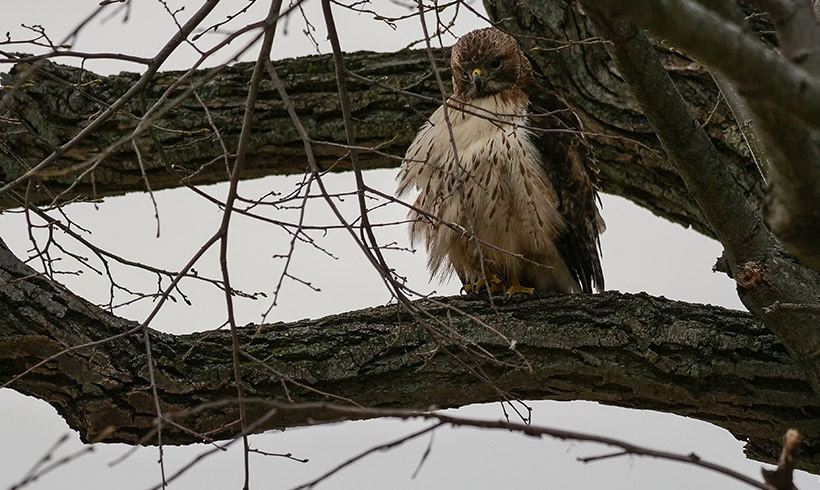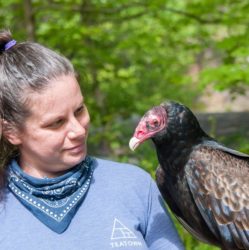The Great Hawk Rescue
Parks are a popular destination for families to gather for picnics and to enjoy the fresh air. There are also wildlife families going about their daily lives, searching for food and raising their young in the same parks.
This story is about a pair of red-tailed hawks that have nested in a local park for many years. They have hunted the fields, raised young, and a handful of dedicated birders have grown to know them quite well.
On March 18, 2021, I received a call that a male red-tailed hawk of a well-known local pair was seen on the ground, unable to fly. With a net, carrier, and towel in hand, I headed out to meet with Charlie Roberto, a dedicated local bird enthusiast and Teatown board member, who was monitoring the bird until help arrived. We quickly caught the bird and secured it in a carrier. Missy Runyan of Friends of the Feathered and Furry Wildlife Center was contacted, and I arranged for the hawk to be transported to her center in the Catskills. Upon assessment, the male red-tailed showed signs of secondary rodenticide poisoning. Luckily, treatment was at hand and this proud male hawk survived.
On April 9, 2021, the hawk was brought back to the same park and a group of local birders got to watch him fly back up into the trees he has called home for so many years. By the next morning I learned that the pair were seen together again, reunited! The number of people invested in the well-being of the pair of hawks has been heartwarming. The stories and amazing photos of the pair are inspiring, and I am grateful that the hawks and other wildlife have so many kind and caring people looking after them.
 Secondary rodenticide poisoning poses a threat to wildlife. Using rodenticide to control rodent populations may seem like an easy fix for a mouse problem, but the unintentional side effects cause significant harm to other creatures. Hawks, owls, foxes, coyotes, and domestic pets are just some that fall victim to secondary poisoning. The target rodent ingests the poison, and the poison travels up the food chain when other animals find an easy meal in a dying or dead rodent.
Secondary rodenticide poisoning poses a threat to wildlife. Using rodenticide to control rodent populations may seem like an easy fix for a mouse problem, but the unintentional side effects cause significant harm to other creatures. Hawks, owls, foxes, coyotes, and domestic pets are just some that fall victim to secondary poisoning. The target rodent ingests the poison, and the poison travels up the food chain when other animals find an easy meal in a dying or dead rodent.
If people continue to use these poisons, next time our hawk, his mate, or one of the many other creatures may not be as lucky.
Please consider alternative methods to rodent control. Poisons or glue traps cause much more suffering and harm than good. A few simple things such as keeping sources of food contained, sealing off areas of entry, and not feeding pets outside will make a big difference in the number of unwanted visitors! Snakes, birds of prey, and other wildlife make amazing, free, and safe rodent control.
Special thanks to:
Missy Runyan, Melissa Gilmer, Charlie Roberto, Bonnie Coe, John Corwin, Steve Sachs, Ray Whitt, Roger Pare, Michelle Bridgman, Lou Ann O’Hora, and Melina Cronin for helping this bird return to the wild.

About The Authors
Phyllis Bock
Director of Education
Phyllis has worked at Teatown since October 1991, when she began as a volunteer Nature Guide. Ms. Bock possesses a BA Biology from Queens College, CUNY. As Director of Education, she takes to heart Teatown’s mission and encourages young and old alike to embrace all that nature has to offer. She can often be found hiking or kayaking somewhere in the Hudson Valley.

Lisa Kelly
Animal Care Supervisor
Lisa started at Teatown in 2007 as a part-time animal caretaker. Now the animal care supervisor, she makes sure all Teatown’s animal ambassadors have everything they need to be mentally and physically healthy. In her free time, Lisa is a wildlife monitor, wildlife rehabilitator, foster home for the local SPCA, and has her own three rescue dogs.


Leave a Reply